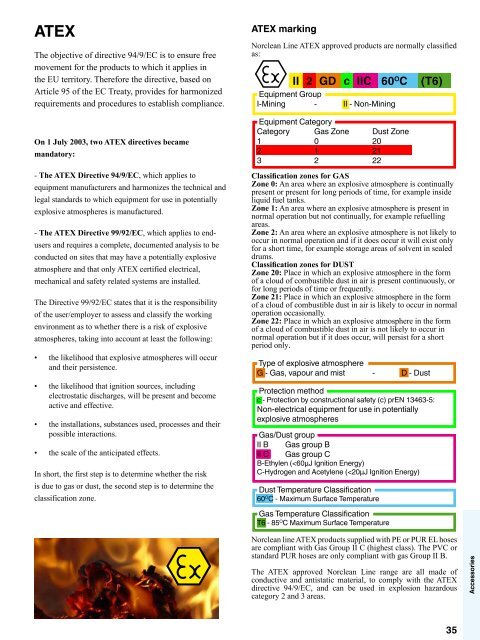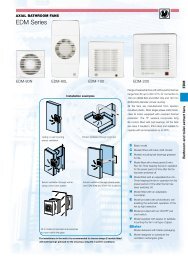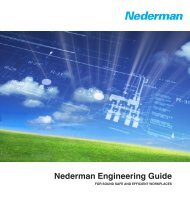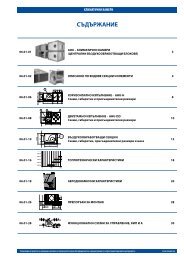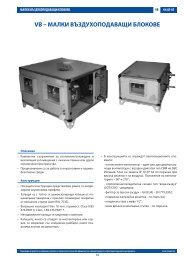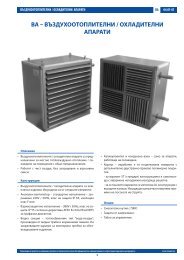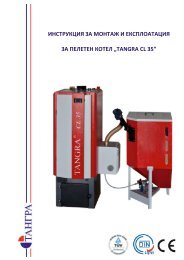You also want an ePaper? Increase the reach of your titles
YUMPU automatically turns print PDFs into web optimized ePapers that Google loves.
ATEX<br />
The objective of directive 94/9/EC is to ensure free<br />
movement for the products to which it applies in<br />
the EU territory. Therefore the directive, based on<br />
Article 95 of the EC Treaty, provides for harmonized<br />
requirements and procedures to establish compliance.<br />
On 1 July 2003, two ATEX directives became<br />
mandatory:<br />
- The ATEX Directive 94/9/EC, which applies to<br />
equipment manufacturers and harmonizes the technical and<br />
legal standards to which equipment for use in potentially<br />
explosive atmospheres is manufactured.<br />
- The ATEX Directive 99/92/EC, which applies to endusers<br />
and requires a complete, documented analysis to be<br />
conducted on sites that may have a potentially explosive<br />
atmosphere and that only ATEX certified electrical,<br />
mechanical and safety related systems are installed.<br />
The Directive 99/92/EC states that it is the responsibility<br />
of the user/employer to assess and classify the working<br />
environment as to whether there is a risk of explosive<br />
atmospheres, taking into account at least the following:<br />
• the likelihood that explosive atmospheres will occur<br />
and their persistence.<br />
• the likelihood that ignition sources, including<br />
electrostatic discharges, will be present and become<br />
active and effective.<br />
• the installations, substances used, processes and their<br />
possible interactions.<br />
• the scale of the anticipated effects.<br />
In short, the first step is to determine whether the risk<br />
is due to gas or dust, the second step is to determine the<br />
classification zone.<br />
ATEX marking<br />
<strong>Norclean</strong> <strong>Line</strong> ATEX approved products are normally classified<br />
as:<br />
II 2 GD c IIC 60 O C (T6)<br />
Equipment Group<br />
I-Mining - II - Non-Mining<br />
Equipment Category<br />
Category Gas Zone Dust Zone<br />
1 0 20<br />
2 1 21<br />
3 2 22<br />
Classification zones for GAS<br />
Zone 0: An area where an explosive atmosphere is continually<br />
present or present for long periods of time, for example inside<br />
liquid fuel tanks.<br />
Zone 1: An area where an explosive atmosphere is present in<br />
normal operation but not continually, for example refuelling<br />
areas.<br />
Zone 2: An area where an explosive atmosphere is not likely to<br />
occur in normal operation and if it does occur it will exist only<br />
for a short time, for example storage areas of solvent in sealed<br />
drums.<br />
Classification zones for DUST<br />
Zone 20: Place in which an explosive atmosphere in the form<br />
of a cloud of combustible dust in air is present continuously, or<br />
for long periods of time or frequently.<br />
Zone 21: Place in which an explosive atmosphere in the form<br />
of a cloud of combustible dust in air is likely to occur in normal<br />
operation occasionally.<br />
Zone 22: Place in which an explosive atmosphere in the form<br />
of a cloud of combustible dust in air is not likely to occur in<br />
normal operation but if it does occur, will persist for a short<br />
period only.<br />
Type of explosive atmosphere<br />
G - Gas, vapour and mist - D - Dust<br />
Protection method<br />
c - Protection by constructional safety (c) prEN 13463-5:<br />
Non-electrical equipment for use in potentially<br />
explosive atmospheres<br />
Gas/Dust group<br />
II B Gas group B<br />
II C Gas group C<br />
B-Ethylen (


